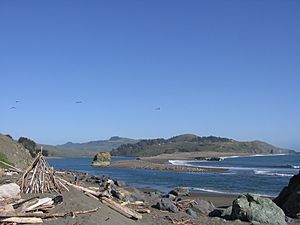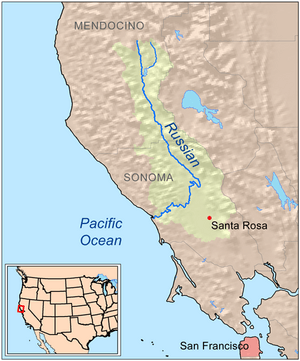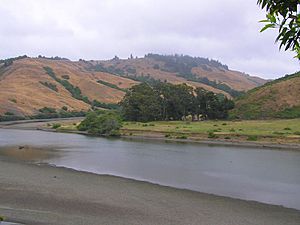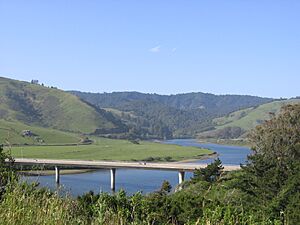Russian River (California) facts for kids
Quick facts for kids Russian River |
|
|---|---|

The estuary of the Russian River, north of Bodega Bay
|
|
 |
|
| Native name | Ashokawna or Bidapte |
| Other name(s) | Slavyanka River Rio San Ygnacio, Rio San Ignacio |
| Country | United States |
| State | California |
| Region | Sonoma County, Mendocino County |
| Cities | Ukiah, Healdsburg |
| Physical characteristics | |
| Main source | Laughlin Range 5 mi (8 km) east of Willits, California 1,960 ft (600 m) 39°23′0″N 123°14′18″W / 39.38333°N 123.23833°W |
| River mouth | Pacific Ocean Jenner, California 0 ft (0 m) 38°27′2″N 123°7′46″W / 38.45056°N 123.12944°W |
| Length | 110 mi (180 km) |
| Basin features | |
| Basin size | 1,485 sq mi (3,850 km2) |
| Tributaries |
|
The Russian River is a river in Northern California. It flows south through Sonoma and Mendocino counties. It covers an area of about 1,485 square miles (3,846 km²).
This river is the second largest in the San Francisco Bay Area. It is about 110 miles (177 km) long. The local Southern Pomo people call it Ashokawna or Bidapte. Early Russian explorers called it the Slavyanka River.
Contents
Where Does the Russian River Flow?

The Russian River starts in the California Coast Ranges. This is about 5 miles (8 km) east of Willits in Mendocino County. It flows south towards Redwood Valley and Calpella. Near Calpella, it meets the East Fork Russian River, just below Lake Mendocino.
From there, the river continues south past Ukiah and Hopland. It then enters Sonoma County, just north of Cloverdale. The river flows through the Alexander Valley. Here, it is joined by Big Sulphur Creek. It passes towns like Cloverdale, Asti, and Geyserville.
East of Healdsburg, Maacama Creek flows into the Russian River. The river then gets water from Lake Sonoma through Dry Creek. The river turns west and is joined by Mark West Creek and Green Valley Creek. It flows past Rio Nido and Guerneville.
Austin Creek joins the river before it reaches Duncans Mills. Finally, the Russian River flows into the Pacific Ocean between Jenner and Goat Rock Beach. The area where the river meets the ocean is called an estuary. It is protected to help wildlife. The mouth of the river is about 60 miles (97 km) north of the San Francisco Bay's Golden Gate bridge.
The lower part of the Russian River is a popular spot for fun activities. In spring, summer, and fall, it's great for swimming and boating. The current is gentle then. But in winter, the river can be dangerous with strong currents and muddy water.
How the River Changed Over Time
A geographer named R. S. Holway studied the Russian River's geology in 1917. He found that the river changed a lot over a long time.
Originally, the Russian River and other rivers flowed west from the Mayacamas Mountains to the sea. Over time, the land was pushed up by natural forces. The Russian River started to cut north into the area where the Navarro River used to flow. It carved its way along a fault line in Alexander Valley. This caused the Russian River to "capture" parts of the Navarro River, like Big Sulphur Creek. This means the water from those areas started flowing into the Russian River instead.
Later, the Russian River was cut off from Clear Lake by a landslide. Now, Clear Lake flows into the Sacramento River. The Russian River also carved a deep canyon into Fitch Mountain a long time ago.
History of the Russian River
The Southern Pomo people, who lived here first, called the river Ashokawna, meaning "east water place," or Bidapte, meaning "big river."
In 1542, explorer Juan Rodríguez Cabrillo might have traveled as far north as the Russian River. The earliest Russian name for the river was Slavyanka, given in 1817. In 1827, the Spanish called it San Ygnacio.
The river gets its current name from Ivan Kuskov. He was a Russian explorer from the Russian-American Company. He explored the river in the early 1800s. He helped set up the Fort Ross colony, which is about 10 miles (16 km) northwest of the river's mouth. The Russians called it the Slavyanka River, which means "Slav River." They built farms near Fort Ross. One farm, Kostromitinov Ranch, was along the Russian River.
In the late 1800s, people came to the river to cut down the redwood trees that grew along its banks.
Other names for the Russian River that have been used include Misallaako, Rio Ruso, and Shabaikai.
How People Use and Change the River
Some water from the Eel River is moved to the Russian River. This happens in Potter Valley through a system called the Potter Valley Project.
The Sonoma County Water Agency takes drinking water from the Russian River. This water is sold to many people in Sonoma, Mendocino, and northern Marin counties. Also, a plant in Santa Rosa cleans sewage water. Some of this cleaned water is returned to the river.
Water that is moved from the Eel River and released from Lake Mendocino flows through the Russian River. This helps the plants and animals that live along the river. However, there's a risk of pollution from accidents on nearby roads or train tracks. For example, in 1982, a chemical spill happened in Ukiah. Emergency teams cleaned up most of it. Water from Lake Mendocino and winter storms helped wash the rest of the chemical out to the ocean.
The Russian River can sometimes flood. In the last half of the 1900s, the river at Guerneville reached flood levels about five times every ten years. Big floods happened in 1986, 1995, 1955, 1964, and 1940. Thanks to the dams at Lake Mendocino and Lake Sonoma, floods have been less common in the 2000s. However, in February 2019, the river flooded to levels similar to 1986.
River Animals and Plants

The Russian River provides a home for many animals. It has both warm and cold freshwater areas. These are important for fish to migrate and lay their eggs.
Long ago, in the early 1800s, a Russian explorer noted that White sturgeon (a very large freshwater fish) were found in the Russian River. These fish can grow very big.
The Russian River is important for Steelhead trout (a type of rainbow trout). Dams and waterfalls have separated steelhead that go to the ocean from those that stay in the river. Studies show that even though many hatchery trout were put into the river, the steelhead here are still native to the area.
For a long time, people thought there weren't many Chinook salmon in the Russian River. But in 2007, a study using underwater cameras found that Chinook salmon have always been, and still are, common in the river. They are a natural, self-sustaining population.
In 2001, there were very few Coho salmon returning to the river to lay eggs. Because of this, a special program was started to help them. Young Coho salmon raised in hatcheries are released into the river. In 2011, over 190 adult Coho salmon may have returned to the river system. Efforts are being made to improve the river's flow and habitat for Coho salmon in creeks like Dutch Bill, Grape, Green Valley, Mark West, and Mill Creek.
Beavers also live in the Russian River area. In the early 1800s, Russian explorers found many beavers and sea otters here. The Russians even set up a settlement partly because of the many beavers. Trappers in the 1830s also reported catching beavers on the Russian River. The local Southern Pomo people have a word for beaver, ṱ’ek:e, and stories about them. In 1881, a newspaper reported that beavers were being trapped near Healdsburg.
The Russian River State Marine Reserve and Russian River State Marine Conservation Area help protect the river's estuary. These areas are like underwater parks. They help keep the ocean and freshwater wildlife and their homes safe.
Russian River Valley
The river helps refill the groundwater and provides water for farming. Many vineyards are located in the river's floodplain. The area known as the Russian River Valley AVA is famous for its wines. It was recognized as a special wine-growing region in 1983 and expanded in 2006. It produces popular wines like Chardonnay and Pinot noir, along with other types. Many wineries, both small and large, are found here.
See also
 In Spanish: Río Ruso para niños
In Spanish: Río Ruso para niños



